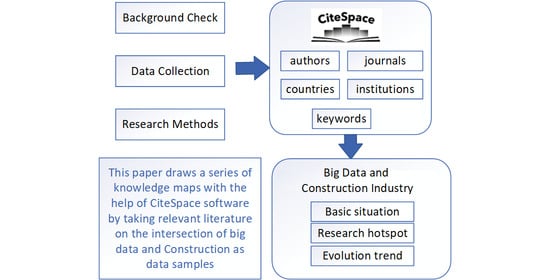Visualization Analysis of Cross Research between Big Data and Construction Industry Based on Knowledge Graph
Abstract
1. Introduction
2. Data Collection and Research Methods
2.1. Data Collection
2.2. Research Methods
3. Results and Discussions
3.1. Analysis of Journal Co-Citation Network
3.2. Analysis of Author Cooperation Network
3.3. Analysis of Country Cooperation Network
3.4. Analysis of Institutional Cooperation Network
3.5. Analysis of Hot Research Topics
- Smart city: The core of the smart city is to fully apply the new generation of information technology in all walks of life in the city, to realize the deep integration of informatization, industrialization, and urbanization, and the high integration of informatization and urbanization, which can help alleviate the “big city disease”, improve the quality of urbanization, realize fine and dynamic management, and enhance the effectiveness of urban management and improve the quality of life of citizens [34]. IBM officially puts forward the vision of a “Smart City”, hoping to contribute to the world’s urban development in 2010 [35]. The smart city is an advanced stage of urban information development and urban governance. As stated by Lin et al. [36] firstly, the evaluation index system of smart city construction readiness is established through literature research and expert interviews. Secondly, the CRITIC and G1 methods are used to determine the subjective and objective weights of the indicators and carry out the combined design. Thirdly, the Bonferroni operator is used to establish the evaluation model of smart city construction readiness, and the final evaluation value of the scheme is calculated and ranked. Finally, the smart city list of 30 cities in China is taken as the empirical research object to provide a decision-making reference for measuring the readiness of smart city construction. From the perspective of technology development, smart city construction requires the application of a new generation of information technology, such as the Internet of Things and cloud computing, represented by mobile technology, to realize comprehensive sensing, analysis, and integration of all key information in the core system of urban operation, to make intelligent responses to various needs, including people’s livelihood, environmental protection, public safety, urban services, industrial and commercial activities, and to create a better urban life for human beings [37]. Numerous scholars internationally have used sensing data, video data, and big data analytics from IoT technologies to comprehensively sense, and correlate key information to support urban management and urban policies [38], modernize urban green transportation [39], intelligently manage human activity information in cities, and remove data and technical barriers between different smart city systems [40].
- Model: Emerging building information modeling tools and technologies are designed to share and transfer data and information-based models of buildings through the entire lifecycle process of project planning, operation, and maintenance, enabling engineers and technicians to possess correct understanding and efficient responses to various building information. It can also provide a basis for collaborative work among design teams and various construction entities, including construction and operation units, and can play an important role in improving productivity, saving costs, and shortening schedules. It can be applied not only in design but also in the whole lifecycle of construction projects [41]. The database of BIM is dynamically changing, constantly being updated, changed, and enriched during the application process. Standardized building components and systems change the way information about the built environment is created, stored, and exchanged [42]. Building information modeling (BIM) is seen as an indispensable opportunity for building, engineering, and the construction (AEC) industry and is a revolutionary technology and process. Lin et al. [43] first proposed a new BIM system model to solve the information security problem in mobile cloud architecture. The proposed bcBIM model can guide the architecture design of further BIM information management systems, especially the BIM cloud as a service for further big data sharing. In addition to allowing not only the understanding of large amounts of data through advanced statistical and visualization methods but also the development of predictive models, and analysis of the full lifecycle of building data. It can also analyze the whole lifecycle of construction data by developing predictive models and sorting out the level of data collection, analysis, discovery, and application. The use of big data technology can guide urban planning, construction, management, operation, and decision support [44], which can serve as the initial stage of big data analysis in the building sector in academia and industry.
- Neural network: The construction industry is one of the largest data industries and one of the less data-driven industries. With the advent of the era of big data, there is an effective way to handle huge data in the construction industry [45]. The use of big data technology can quickly analyze the depth of value in a large amount of data information, and applying it to the intelligent building is conducive to designing and improving the energy-saving process of the building in the optimization of the building structure [46]. Neural networks can learn and build models of complex nonlinear relationships, it can also predict unknown data by inferring unknown relationships between unknown data [47]. Currently, the construction industry has begun to process large amounts of data and extract its value, and the difficulty of sharing data among business information systems has led to the inability to integrate resources that would help in making the decision [48]. International scholars use neural networks in construction to overcome such drawbacks, integrate databases and information sources from suppliers, optimize off-site construction [49], and accurately and reliably identify equipment activities [50]. Improving the overall capability of construction organization and management [51] provides a theoretical basis for achieving data sharing and interoperability between companies and projects [52].
- Management: In the context of big data, there is a huge change in the management mode aspect of construction projects, which has been transformed and developed from the traditional engineering management approach to an information management approach. The construction industry generates data beyond the existing data management and analysis capabilities within the industry from the start of a project to its delivery [4], and big data technologies can be used to process massive amounts of data by using advanced statistical and visualization methods to inform future decisions [16]. In the process of construction management of engineering buildings nowadays, the requirements for technical understanding are getting higher and higher, and the number of information technologies used by construction units is rising. Widely used technologies include Internet of Things technology, cloud computing technology, and mass storage technology. Using these advanced technologies, staff can be more efficient in construction management [53]. Engineering managers can use big data technology, 5G technology, and Internet of Things technology to create a quality management platform for engineering projects, which can promote the goal of real-time sharing of construction information and enable the participating units to participate in quality management of the project. It is conducive to improving the overall construction quality of the building project [54]. Engineering managers can also use big data mining techniques [55] able to check and analyze the possible quality problems at the construction site building engineering early. The implementation of dynamic management of the whole process of construction projects can optimize the handling of important factors affecting the quality of engineering construction [56]. In the process of construction project quality management, cost management, safety management, project construction quality management, and construction progress management should be carried out for the whole construction project based on big data mining technology to improve the analysis and decision-making work [57].
- System: In recent years, the development of computer technology and network communication technology has made society highly informative, and the application of information technology and construction technology inside buildings has resulted in a new industry of “building intelligence” [51]. Building intelligent system refers to the building as a platform, and also has three major systems of building equipment, office automation, and communication networks. It integrates structure, systems, services, management, and the optimal combination among them to provide people with a safe, efficient, comfortable, and convenient built environment [58]. Building an intelligent system uses modern communication technology, information technology, computer network technology, monitoring technology, etc., to realize intelligent control and management of buildings through automatic detection, optimal control of buildings, building equipment, and optimal management of information resources, to meet the needs of users for monitoring, management, and information sharing of buildings, thus, making intelligent buildings safe, comfortable, efficient and environmentally friendly, and achieving the goal of reasonable investment and adapting to the needs of the information society [21]. Big data technologies can also guide intelligent prevention by building intelligent information security collaboration systems [59], intelligent disaster warning systems [60], and intelligent traffic coordination systems based on road sensors [61]. Established reliable data-sharing mechanisms protect personal privacy and data security, manage large amounts of data from various sources, and provide guidance for smart prevention [62].
3.6. Analysis of Frontiers Trending
3.7. Discussion
- From the basic situation of research, the research at the intersection of big data and building science has been preliminarily mature. In the future, the cooperation between academic teams should be strengthened to deepen communication and exchanges, and the cooperation between universities, enterprises, research institutes, and other research institutions should be strengthened to jointly commit to the long-term development of the cross-field between big data and the construction industry. From the perspective of research hotspots, the vigorous development of digital technology in the field of engineering construction represented by BIM technology brings new opportunities for the design, construction, operation, and maintenance technology improvement of large-scale construction projects. The arrival of the era of big data has brought opportunities and challenges to the development of cities. The development of smart cities can effectively relieve the severe housing pressure, and also greatly relieve the pressure on energy and resources. Under the background of the continuous development and application of the Internet of Things technology, sensors have more and more applications in civil engineering, and the frequency of data collection is getting higher and higher, which has a good role in promoting the innovation and development of civil engineering technology. The use of big data technology to explore basic laws has become an inevitable trend in the current civil engineering construction and development process, and big data technology has gradually become a supporting technology in the field of civil engineering. Engineers can have a more scientific and reasonable basis through the use of these laws in the construction, maintenance, and management of civil engineering. From the perspective of evolutionary trends, the development of the construction industry is closely related to the development of science and technology. The progress of computer and intelligent technology promotes the development of the construction industry in the direction of recycling, green, sustainable, and intelligent. In the future, the construction industry will be inseparable from the research and application of big data, BIM, the Internet of things, cloud technology, and other emerging technologies, and is committed to the realization of smart cities and green and sustainable buildings. With the rapid development of the social economy and the continuous improvement of people’s living standards, people have higher comprehensive requirements for architecture and new demands for architectural connotations. The reasonable choice of building address, layout, and style will also be an important development direction for the future construction industry.
- Access to classic literature at the intersection of big data and architecture by querying software backend information. It can be found by reading that big data technology, with its convenient and fast data processing, is particularly in line with the development characteristics of modern civil engineering construction. The construction process of the actual projects of civil engineering, bridges, and tunnels, contains very complicated and diverse content, and the application objects actually targeted by the work stages in different periods are very different. For this, the engineering project can be divided into several stages of work, and the multiple stages mainly include the design stage, construction stage, operation stage, etc. In the whole process, it is necessary to increase the strength of big data applications and give full play to their advantages [73]. In the design phase, where the initial planning of the project directly affects the subsequent structure and function, the application of big data technology to the project will help develop more efficient design models that allow designers to understand various information such as scale, function, and cost [74]. On top of that, big data technologies can also be used to collect and process information similar to civil engineering, identify similarities with civil engineering, and serve as an important guide to optimizing design [75]. The design of artificial intelligence-assisted civil engineering is currently in its infancy, but it has shown great promise. Many details must be paid attention to during the construction phase, and improper control can cause many problems and affect the normal operation of the building. Using the current stage of large-scale data processing technology, construction problems can be avoided and the quality and reliability of construction operations can be improved [76]. Using big data technology to collect information on civil construction problems classifies construction problems and identifies their causes. It helps to take preventive measures based on the actual situation at the construction site to prevent construction problems and ensure that civil construction continues to proceed smoothly as planned [77]. In the construction process, the application of big data technology can be combined with the current investment situation to collect and analyze the supporting conditions of the project and pre-select various construction sites to ensure the rationality of the later construction, which can better improve the construction efficiency and safety of the building [78]. Compared with other stages, the operation and maintenance stage is easier to obtain data information, and the amount of data is relatively large. Therefore, the relevant decisions to be implemented in this part of the work are more diverse [79]. Therefore, importance can be attached to the value of big data technology in this phase of work, such as the use of drones, computer vision, deep learning, and other technologies to complete this phase of work, so as to better exploit the potential of big data and provide reliable scientific data support for the operation and maintenance of buildings.
- Through the above analysis, we can clarify that the considerations of big data technology in civil engineering mainly contain the following points. Firstly, the data source is the basis of data analysis in the engineering of applying big data technology, which appears to be extremely important in the whole technical application. The location of the sensors needs to be reasonably analyzed to determine the number and location of sensors to better obtain accurate data sources. Because the data source of the construction project mainly comes from the sensor and photographic image acquisition. Similarly, it is necessary to focus on data transmission, analysis, feature extraction, and other issues to improve the effectiveness of data sources when using image equipment for image acquisition of buildings. Secondly, the amount of data to be analyzed needs to be chosen reasonably. As the research becomes more and more extensive over time, the amount of data will continue to accumulate, and too much data accumulation will cause difficulties in analysis. Therefore, it is necessary to continuously try and figure out the size of the data source according to the measurement data, and find the size of data applicable to the project, so as to guarantee the speed and convenience of data analysis. Finally, a reasonable data analysis method should be used. There are various data analysis methods in big data technology, but different analysis methods produce different results in terms of accuracy and time spent. We need to analyze the rationality of the chosen method and compare different analysis methods to select the most appropriate data analysis approach or to improve the analysis methods for certain data when using data analysis methods.
4. Conclusions
Author Contributions
Funding
Institutional Review Board Statement
Informed Consent Statement
Data Availability Statement
Conflicts of Interest
References
- Hariri, R.H.; Fredericks, E.M.; Bowers, K.M. Uncertainty in big data analytics: Survey, opportunities, and challenges. J. Big. Data 2019, 6, 44. [Google Scholar] [CrossRef]
- Wang, X.D.; Zhu, X.Q.; Wu, G.Q.; Ding, W. Data Mining with big data. IEEE Trans. Knowl. Data Eng. 2014, 26, 97–107. [Google Scholar]
- Song, I.Y.; Zhu, Y. Big data and data science: What should we teach? Expert Syst. 2016, 33, 364–373. [Google Scholar] [CrossRef]
- Bilal, M.; Oyedele, L.O.; Qadir, J.; Munir, K.; Ajayi, S.O.; Akinade, O.O.; Owolabi, H.A.; Alaka, H.A.; Pasha, M. Big Data in the construction industry: A review of present status, opportunities, and future trends. Adv. Eng. Inf. 2016, 30, 500–521. [Google Scholar] [CrossRef]
- Abioye, S.O.; Oyedele, L.O.; Akanbi, L.; Ajayi, A.; Delgado, J.M.D.; Bilal, M.; Akinade, O.O.; Ahmed, A. Artificial intelligence in the construction industry: A review of present status, opportunities and future challenges. J. Build. Eng. 2021, 44, 103299. [Google Scholar]
- Abdelrahman, M.M.; Zhan, S.; Miller, C.; Chong, A. Data science for building energy efficiency: A comprehensive text-mining driven review of scientific literature. Energy Build. 2021, 242, 110885. [Google Scholar] [CrossRef]
- Srivastava, A.; Jawaid, S.; Singh, R.; Gehlot, A.; Akram, S.V.; Priyadarshi, N.; Khan, B.; Liu, H. Imperative Role of Technology Intervention and Implementation for Automation in the Construction Industry. Adv. Civ. Eng. 2022, 2022, 6716987. [Google Scholar]
- Nsengiyumva, W.; Zhong, S.; Luo, M.; Zhang, Q.; Lin, J. Critical insights into the state-of-the-art NDE data fusion techniques for the inspection of structural systems. Struct. Control Health Monit. 2021, 29, e2857. [Google Scholar]
- Zhu, S.; Li, D.; Feng, H.; Gu, T.; Hewage, K.; Sadiq, R. Smart city and resilient city: Differences and connections. WIREs Data Min. Knowl. Discov. 2020, 10, e1388. [Google Scholar]
- Lee, P.N.; Fry, J.S.; Forey, B.A. A review of the evidence on smoking bans and incidence of heart disease. Regul. Toxicol. Pharmacol. 2014, 70, 7–23. [Google Scholar] [CrossRef] [PubMed]
- Azmoon, B.; Biniyaz, A.; Liu, Z.; Sun, Y. Image-Data-Driven Slope Stability Analysis for Preventing Landslides Using Deep Learning. IEEE Access 2021, 9, 150623–150636. [Google Scholar] [CrossRef]
- Aguilar, J.; Garces-Jimenez, A.; R-Moreno, M.D.; Garcia, R. A systematic literature review on the use of artificial intelligence in energy self-management in smart buildings. Renew. Sustain. Energy Rev. 2021, 151, 111530. [Google Scholar] [CrossRef]
- Erkoreka, A.; Garcia, E.; Martin, K.; Teres-Zubiaga, J.; Del Portillo, L. In-use office building energy characterization through basic monitoring and modelling. Energy Build. 2016, 119, 256–266. [Google Scholar] [CrossRef]
- Zekic-Susac, M.; Has, A.; Knezevic, M. Predicting energy cost of public buildings by artificial neural networks, CART, and random forest. Neurocomputing 2021, 439, 223–233. [Google Scholar] [CrossRef]
- Amasyali, K.; El-Gohary, N.M. A review of data-driven building energy consumption prediction studies. Renew. Sustain. Energy Rev. 2018, 81, 1192–1205. [Google Scholar] [CrossRef]
- Bilal, M.; Oyedele, L.O.; Kusimo, H.O.; Owolabi, H.A.; Akanbi, L.A.; Ajayi, A.O.; Akinade, O.O.; Delgado, J.M.D. Investigating profitability performance of construction projects using big data: A project analytics approach. J. Build. Eng. 2019, 26, 100850. [Google Scholar] [CrossRef]
- Chen, S. Construction Project Cost Management and Control System Based on Big Data. Mob. Inf. Syst. 2022, 2022, 7908649. [Google Scholar] [CrossRef]
- Liang, Y.P.; Ashuri, B.A.B.; Li, M.S. Forecasting the Construction Expenditure Cash Flow for Transportation Design-Build Projects with a Case-Based Reasoning Model. J. Constr. Eng. Manag. 2021, 147, 04021043. [Google Scholar] [CrossRef]
- Cho, D.; Lee, M.; Shin, J. Development of Cost and Schedule Data Integration Algorithm Based on Big Data Technology. Appl. Sci. 2020, 10, 8917. [Google Scholar] [CrossRef]
- Flah, M.; Nunez, I.; Ben Chaabene, W.; Nehdi, M.L. Machine Learning Algorithms in Civil Structural Health Monitoring: A Systematic Review. Arch. Comput. Methods Eng. 2020, 28, 2621–2643. [Google Scholar] [CrossRef]
- Kim, D.; Yoon, Y.; Lee, J.; Mago, P.J.; Lee, K.; Cho, H. Design and Implementation of Smart Buildings: A Review of Current Research Trend. Energies 2022, 15, 4278. [Google Scholar] [CrossRef]
- Guo, P.; Tian, W.; Li, H.; Zhang, G.; Li, J. Global characteristics and trends of research on construction dust: Based on bibliometric and visualized analysis. Environ. Sci. Pollut. Res. Int. 2020, 27, 37773–37789. [Google Scholar] [CrossRef] [PubMed]
- Salunkhe, A.A.; Gobinath, R.; Vinay, S.; Joseph, L. Progress and Trends in Image Processing Applications in Civil Engineering: Opportunities and Challenges. Adv. Civ. Eng. 2022, 220, 6400254. [Google Scholar] [CrossRef] [PubMed]
- Chen, B.; Shin, S.; Wu, M.; Liu, Z. Visualizing the Knowledge Domain in Health Education: A Scientometric Analysis Based on CiteSpace. Int. J. Environ. Res. Public. Health 2022, 19, 6440. [Google Scholar] [CrossRef]
- Dong, Y.; Liu, L.; Han, J.; Zhang, L.; Wang, Y.; Li, J.; Li, Y.; Liu, H.; Zhou, K.; Li, L.; et al. Worldwide Research Trends on Artemisinin: A Bibliometric Analysis From 2000 to 2021. Front. Med. 2022, 9, 868087. [Google Scholar] [CrossRef]
- Feng, L.; Shang, S.; Feng, X.; Kong, Y.; Bai, J. Evolution and Trend Analysis of Research Hotspots in the Field of Pollution-Intensive Industry Transfer—Based on Literature Quantitative Empirical Study of China as World Factory. Front. Environ. Sci. 2022, 10, 732734. [Google Scholar] [CrossRef]
- Huang, Y.; Zhan, Q.; Wu, C.; Liao, N.; Jiang, Z.; Ding, H.; Wang, K.; Li, Y. Trends and Hotspots in Nanoparticles for the Targeted Delivery of Nucleic Acids: A Ten-Year Bibliometric Study. Front. Pharmacol. 2022, 13, 868398. [Google Scholar] [CrossRef]
- Umeokafor, N.; Umar, T.; Evangelinos, K. Bibliometric and scientometric analysis-based review of construction safety and health research in developing countries from 1990 to 2021. Saf. Sci. 2022, 156, 105897. [Google Scholar] [CrossRef]
- Xu, X.; Li, Y.; Shi, S.; Lv, J.; Wang, Y.; Zheng, H.; Mao, X.; Wu, H.; Zhang, B.; Song, Q. The Application of Angiotensin Receptor Neprilysin Inhibitor in Cardiovascular Diseases: A Bibliometric Review From 2000 to 2022. Front. Cardiovasc. Med. 2022, 9, 899235. [Google Scholar] [CrossRef] [PubMed]
- Xue, J.; Zhang, W.; Rasool, Z.; Zhou, J. A review of supply chain coordination management based on bibliometric data. Alex. Eng. J. 2022, 61, 10837–10850. [Google Scholar] [CrossRef]
- Zhang, S.; Huang, M.; Zhi, J.; Wu, S.; Wang, Y.; Pei, F. Research Hotspots and Trends of Peripheral Nerve Injuries Based on Web of Science From 2017 to 2021: A Bibliometric Analysis. Front. Neurol. 2022, 13, 872261. [Google Scholar] [CrossRef] [PubMed]
- Zhao, J.; Lu, Y.; Zhou, F.; Mao, R.; Fei, F. Systematic Bibliometric Analysis of Research Hotspots and Trends on the Application of Virtual Reality in Nursing. Front. Public. Health 2022, 10, 906715. [Google Scholar] [CrossRef] [PubMed]
- Zhu, G.; Fu, Z.; Su, S.; Tang, Y.; Liu, F.; Yu, W. Global Trends and Hotspots in Trigeminal Neuralgia Research From 2001 to 2021: A Bibliometric Analysis. Front. Neurol. 2022, 13, 894006. [Google Scholar] [CrossRef]
- Jin, J.; Gubbi, J.; Marusic, S.; Palaniswami, M. An information framework for creating a smart city through internet of things. IEEE Internet Things J. 2014, 1, 112–121. [Google Scholar] [CrossRef]
- Zanella, A.; Bui, N.; Castellani, A.; Vangelista, L.; Zorzi, M. Internet of things for smart cities. IEEE Internet Things J. 2014, 1, 22–32. [Google Scholar] [CrossRef]
- Xia, H.S.; Liu, Z.S.; Efremochkina, M.; Liu, X.T.; Lin, C.X. Study on city digital twin technologies for sustainable smart city design: A review and bibliometric analysis of geographic information system and building information modeling integration. Sustain. Cities Soc. 2022, 84, 104009. [Google Scholar] [CrossRef]
- Ju, J.; Liu, L.; Feng, Y. Citizen-centered big data analysis-driven governance intelligence framework for smart cities. Telecommun. Policy 2018, 42, 881–896. [Google Scholar] [CrossRef]
- Tian, L.; Wang, H.; Zhou, Y.; Peng, C. Video big data in smart city: Background construction and optimization for surveillance video processing. Future Gener. Comput. Syst. 2018, 86, 1371–1382. [Google Scholar] [CrossRef]
- Zhou, J.; Wang, P.; Xie, L. Research on Resource Allocation Optimization of Smart City Based on Big Data. IEEE Access 2020, 8, 158852–158861. [Google Scholar] [CrossRef]
- Marinakis, V.; Doukas, H.; Tsapelas, J.; Mouzakitis, S.; Sicilia, A.; Madrazo, L.; Sgouridis, S. From big data to smart energy services: An application for intelligent energy management. Future Gener. Comput. Syst. 2020, 110, 572–586. [Google Scholar] [CrossRef]
- Liu, X.; Wang, X.Y.; Wright, G.; Cheng, J.C.P.; Li, X.; Liu, R. A State-of-the-art review on the integration of building information modeling (bim) and geographic information system (GIS). ISPRS Int. J. Geo-Inf. 2017, 6, 53. [Google Scholar] [CrossRef]
- Leon-Garza, H.; Hagras, H.; Pena-Rios, A.; Conway, A.; Owusu, G. A type-2 fuzzy system-based approach for image data fusion to create building information models. Inf. Fusion 2022, 88, 115–125. [Google Scholar] [CrossRef]
- Zheng, R.Y.; Jiang, J.L.; Hao, X.H.; Ren, W.; Xiong, F.; Ren, Y. bcBIM: A Blockchain-Based big data model for bim modification audit and provenance in mobile cloud. math. Probl. Eng. 2019, 2019, 5349538. [Google Scholar] [CrossRef]
- Yu, Z.; Zheng, X.; Huang, F.; Guo, W.; Sun, L.; Yu, Z. A framework based on sparse representation model for time series prediction in smart city. Front. Comput. Sci. 2020, 15, 151305. [Google Scholar] [CrossRef]
- Bello, S.A.; Oyedele, L.O.; Akinade, O.O.; Bilal, M.; Davila Delgado, J.M.; Akanbi, L.A.; Ajayi, A.O.; Owolabi, H.A. Cloud computing in construction industry: Use cases, benefits and challenges. Autom. Constr. 2021, 122, 103441. [Google Scholar] [CrossRef]
- Chen, Z.; Jiang, C. Building occupancy modeling using generative adversarial network. Energy Build. 2018, 174, 372–379. [Google Scholar] [CrossRef]
- Chen, X.; Wang, H.; Tian, B. Visualization model of big data based on self-organizing feature map neural network and graphic theory for smart cities. Cluster. Comput. 2018, 22, 13293–13305. [Google Scholar] [CrossRef]
- Bae, J.; Choi, K.; Oh, J.H. Multicontextual Machine-Learning Approach to Modeling Traffic Impact of Urban Highway Work Zones. Transp. Res. Rec. 2017, 2645, 184–194. [Google Scholar] [CrossRef]
- Gbadamosi, A.Q.; Oyedele, L.; Mahamadu, A.M.; Kusimo, H.; Bilal, M.; Delgado, J.M.D.; Muhammed-Yakubu, N. Big data for Design Options Repository: Towards a DFMA approach for offsite construction. Autom. Constr. 2020, 120, 103388. [Google Scholar] [CrossRef]
- Rashid, K.M.; Louis, J. Times-series data augmentation and deep learning for construction equipment activity recognition. Adv. Eng. Inf. 2019, 42, 100944. [Google Scholar] [CrossRef]
- You, Z.; Feng, L. Integration of Industry 4.0 Related Technologies in Construction Industry: A Framework of Cyber-Physical System. IEEE Access 2020, 8, 122908–122922. [Google Scholar] [CrossRef]
- You, Z.; Wu, C. A framework for data-driven informatization of the construction company. Adv. Eng. Inf. 2019, 39, 269–277. [Google Scholar] [CrossRef]
- Ngo, J.; Hwang, B.G. Critical Project Management knowledge and skills for managing projects with smart technologies. J. Manag. Eng. 2022, 38, 05022013. [Google Scholar] [CrossRef]
- Liu, H.; Zhang, H.; Zhang, R.X.; Jiang, H.B.; Ju, Q.Q. Competence model of construction project manager in the digital era—The case from China. Buildings 2022, 12, 1385. [Google Scholar] [CrossRef]
- Zheng, J.; Wen, Q.; Qiang, M. Understanding demand for project manager competences in the construction industry: Data mining approach. J. Constr. Eng. Manag. 2020, 146, 04020083. [Google Scholar] [CrossRef]
- Valipour, A.; Yahaya, N.; Md Noor, N.; Antucheviciene, J.; Tamosaitiene, J. Hybrid SWARA-COPRAS method for risk assessment in deep foundation excavation project: An iranian case study. J. Civ. Eng. Manag. 2017, 23, 524–532. [Google Scholar] [CrossRef]
- Kifokeris, D.; Xenidis, Y. Constructability: Outline of Past, Present, and Future Research. J. Constr. Eng. Manag. 2017, 143, 04017035. [Google Scholar] [CrossRef]
- Hosamo, H.H.; Svennevig, P.R.; Svidt, K.; Han, D.; Nielsen, H.K. A Digital Twin predictive maintenance framework of air handling units based on automatic fault detection and diagnostics. Energy Build. 2022, 261, 111988. [Google Scholar] [CrossRef]
- Wu, S.; Guo, D.; Wu, Y.; Wu, Y. Future Development of Taiwan’s Smart Cities from an Information Security Perspective. Sustainability 2018, 10, 4520. [Google Scholar] [CrossRef]
- Kim, J.S.; Kim, B.S. Analysis of Fire-Accident Factors Using Big-Data Analysis Method for Construction Areas. KSCE J. Civ. Eng. 2017, 22, 1535–1543. [Google Scholar] [CrossRef]
- Bellini, P.; Benigni, M.; Billero, R.; Nesi, P.; Rauch, N. Km4City ontology building vs data harvesting and cleaning for smart-city services. J. Vis. Lang. Comput. 2014, 25, 827–839. [Google Scholar] [CrossRef]
- Kim, K.; Kim, H.; Kim, H. Image-based construction hazard avoidance system using augmented reality in wearable device. Autom. Constr. 2017, 83, 390–403. [Google Scholar] [CrossRef]
- Lin, J.R.; Hu, Z.Z.; Zhang, J.P.; Yu, F.Q. A Natural-Language-Based Approach to Intelligent Data Retrieval and Representation for Cloud BIM. Comput.-Aided Civ. Infrastruct. Eng. 2016, 31, 18–33. [Google Scholar] [CrossRef]
- Wong, J.K.W.; Zhou, J. Enhancing environmental sustainability over building life cycles through green BIM: A review. Autom. Constr. 2015, 57, 156–165. [Google Scholar] [CrossRef]
- Chen, Y.; Han, D. Water quality monitoring in smart city: A pilot project. Autom. Constr. 2018, 89, 307–316. [Google Scholar] [CrossRef]
- Chen, X.; Lu, W. Identifying factors influencing demolition waste generation in Hong Kong. J. Clean. Prod. 2017, 141, 799–811. [Google Scholar] [CrossRef]
- Boje, C.; Guerriero, A.; Kubicki, S.; Rezgui, Y. Towards a semantic Construction Digital Twin: Directions for future research. Autom. Constr. 2020, 114, 103179. [Google Scholar] [CrossRef]
- Becker, M.; Elsmann, T.; Latka, I.; Rothhardt, M.; Bartelt, H. Chirped Phase Mask Interferometer for Fiber Bragg Grating Array Inscription. J. Light. Technol. 2015, 33, 2093–2098. [Google Scholar] [CrossRef]
- Miller, C.; Nagy, Z.; Schlueter, A. A review of unsupervised statistical learning and visual analytics techniques applied to performance analysis of non-residential buildings. Renew. Sustain. Energy Rev. 2018, 81, 1365–1377. [Google Scholar]
- Perera, S.; Nanayakkara, S.; Rodrigo, M.N.N.; Senaratne, S.; Weinand, R. Blockchain technology: Is it hype or real in the construction industry? J. Ind. Inf. Integr. 2020, 17, 100125. [Google Scholar] [CrossRef]
- Zhang, W.; Li, H.; Li, Y.; Liu, H.; Chen, Y.; Ding, X. Application of deep learning algorithms in geotechnical engineering: A short critical review. Artif. Intell. Rev. 2021, 54, 5633–5673. [Google Scholar] [CrossRef]
- Wu, Y.; Tan, H.; Qin, L.; Ran, B.; Jiang, Z. A hybrid deep learning based traffic flow prediction method and its understanding. Transp. Res. Pt. C-Emerg. Technol. 2018, 90, 166–180. [Google Scholar] [CrossRef]
- Huang, Y.; Shi, Q.; Zuo, J.; Pena-Mora, F.; Chen, J.; Yi, W. Research Status and Challenges of Data-Driven Construction Project Management in the Big Data Context. Adv. Civ. Eng. 2021, 2021, 6674980. [Google Scholar] [CrossRef]
- Catbas, F.N.; Malekzadeh, M. A machine learning-based algorithm for processing massive data collected from the mechanical components of movable bridges. Autom. Constr. 2016, 72, 269–278. [Google Scholar] [CrossRef]
- Scianna, A.; Gaglio, G.F.; La Guardia, M. Structure Monitoring with BIM and IoT: The Case Study of a Bridge Beam Model. ISPRS Int. J. Geo-Inf. 2022, 11, 173. [Google Scholar] [CrossRef]
- Wang, D.; Fan, J.; Fu, H.; Zhang, B. Research on Optimization of Big Data Construction Engineering Quality Management Based on RNN-LSTM. Complexity 2018, 2018, 9691868. [Google Scholar] [CrossRef]
- Fang, W.; Luo, H.; Xu, S.; Love, P.E.D.; Lu, Z.; Ye, C. Automated text classification of near-misses from safety reports: An improved deep learning approach. Adv. Eng. Inf. 2020, 44, 101060. [Google Scholar] [CrossRef]
- Gumusay, M.U.; Koseoglu, G.; Bakirman, T. An assessment of site suitability for marina construction in Istanbul, Turkey, using GIS and AHP multicriteria decision analysis. Environ. Monit. Assess. 2016, 188, 677. [Google Scholar] [CrossRef]
- Sakkas, N.P.; Abang, R. Thermal load prediction of communal district heating systems by applying data-driven machine learning methods. Energy Rep. 2022, 8, 1883–1895. [Google Scholar] [CrossRef]
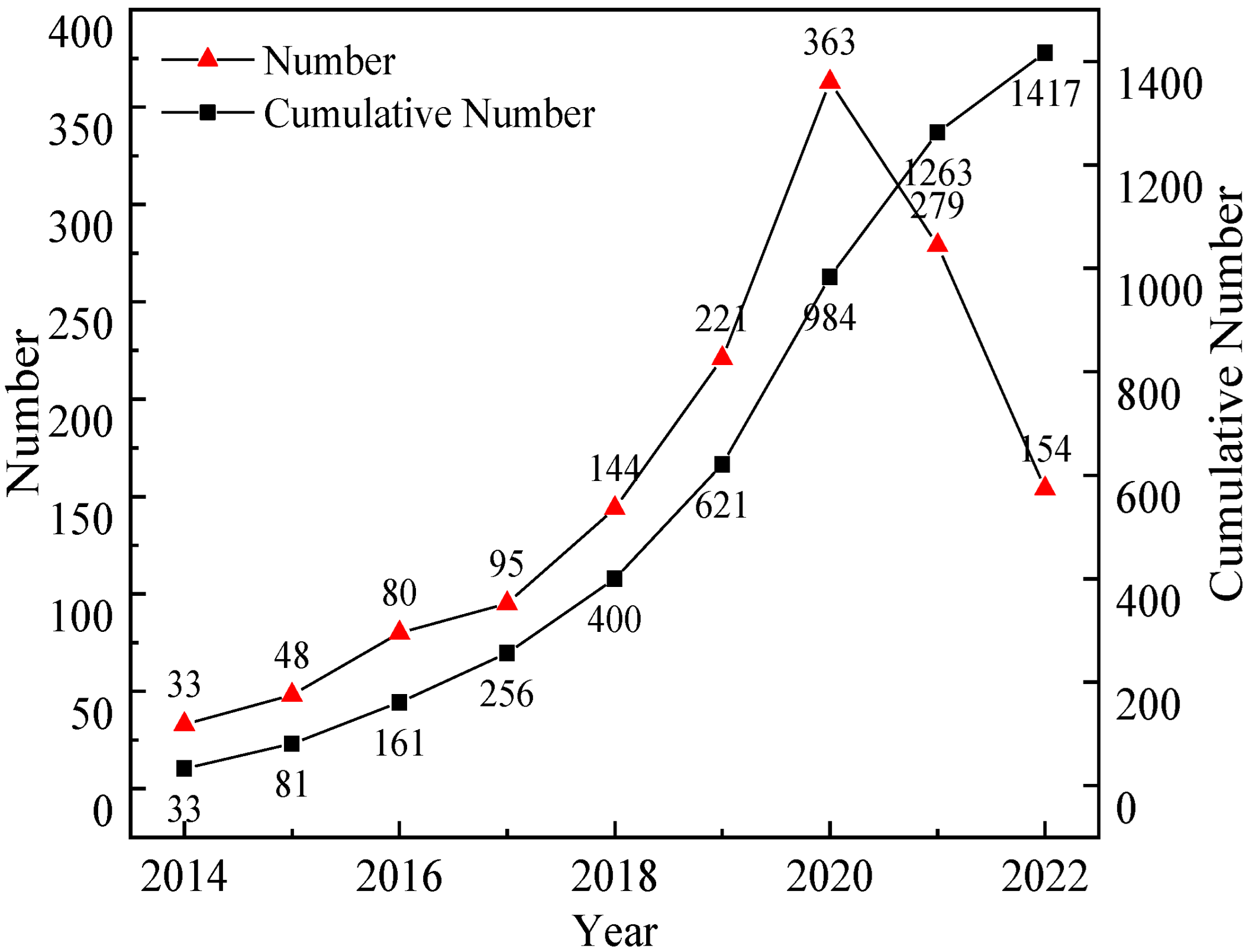
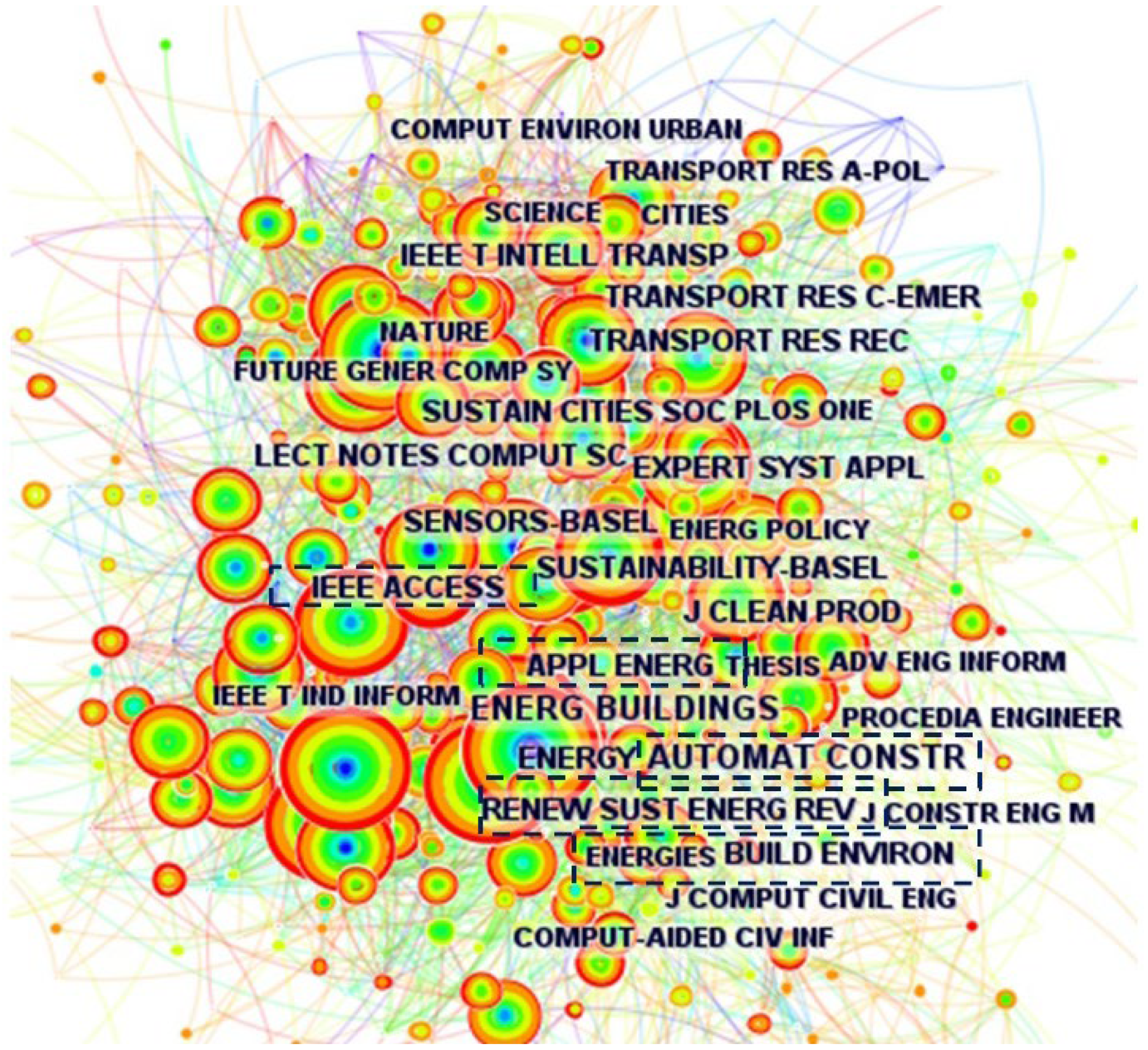

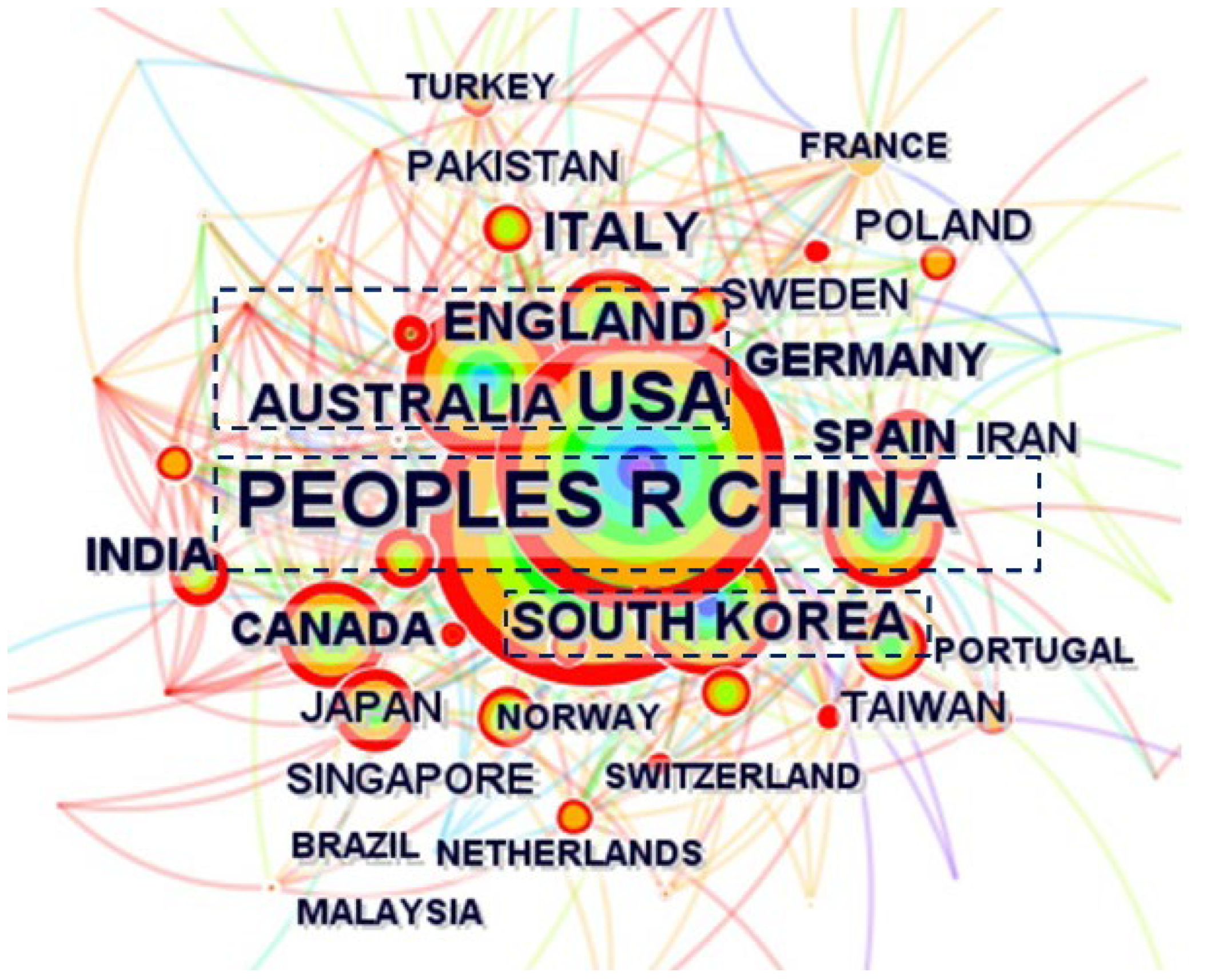
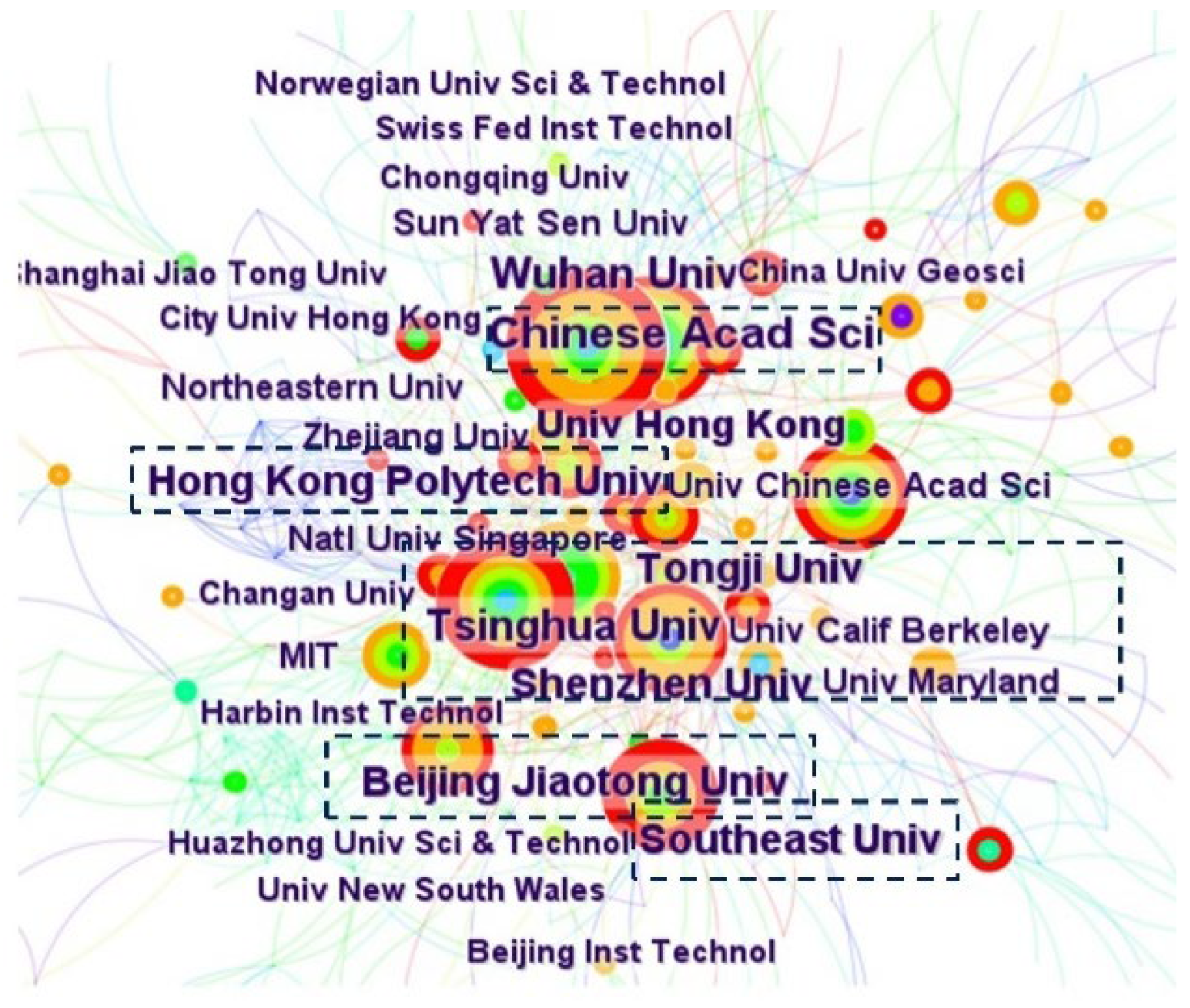
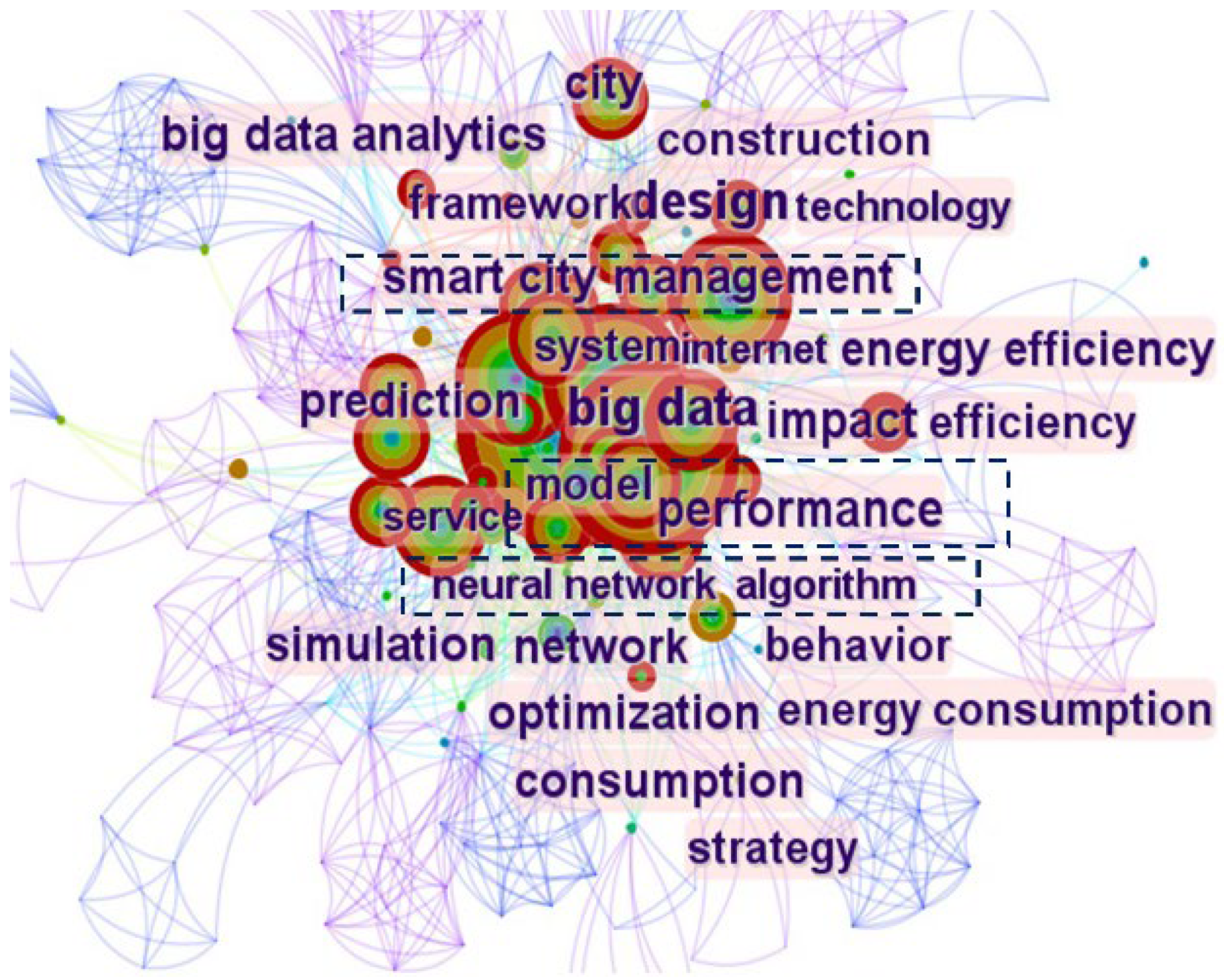
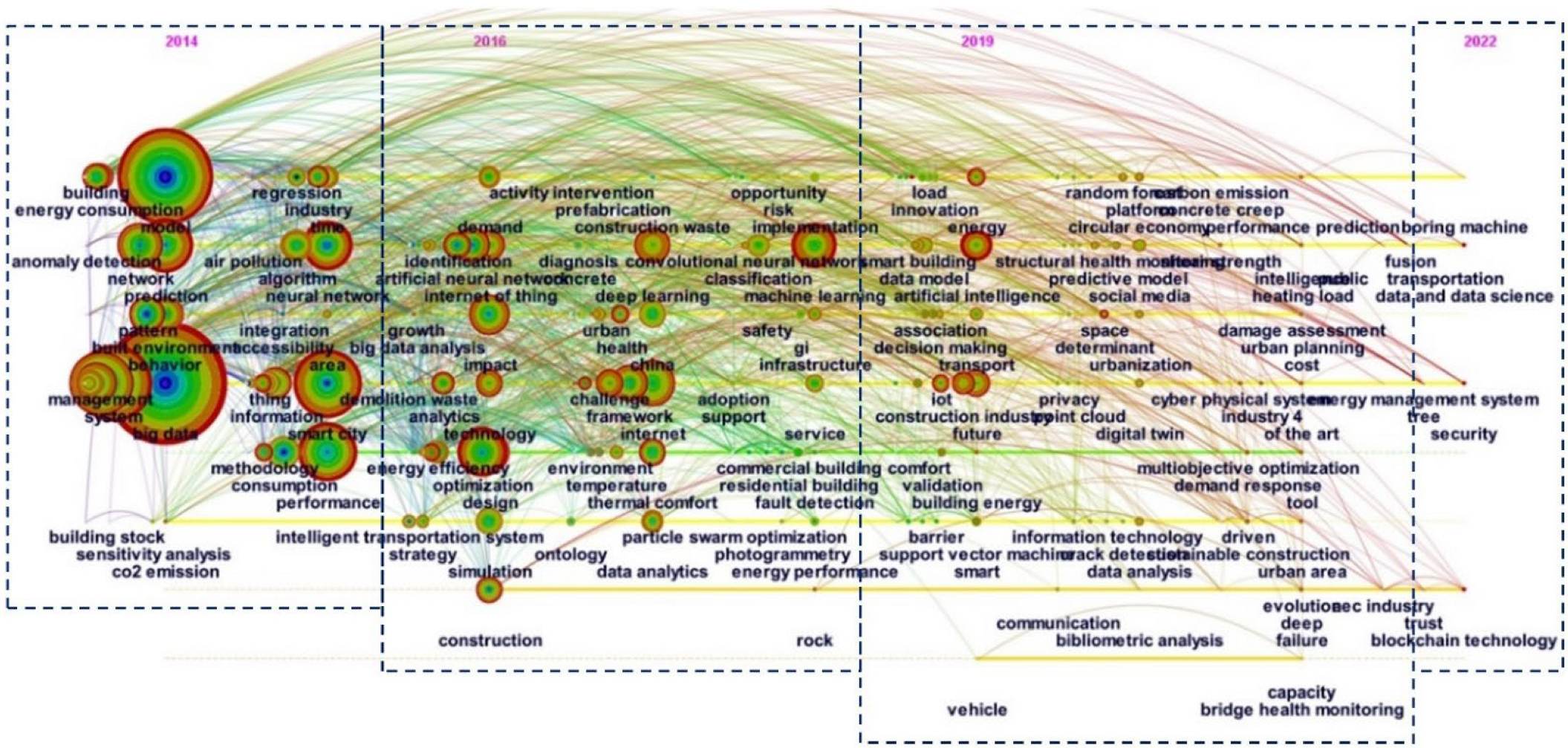
| Ranker | Cited Frequency | Centrality | Journal |
|---|---|---|---|
| 1 | 231 | 0.03 | Automation in Construction |
| 2 | 230 | 0.02 | Energy and Buildings |
| 3 | 214 | 0.01 | Renewable and Sustainable Energy Reviews |
| 4 | 213 | 0.03 | Applied Energy |
| 5 | 207 | 0.02 | Transportation Research Record |
| 6 | 200 | 0.03 | IEEE Access |
| 7 | 198 | 0.01 | Building and Environment |
| 8 | 193 | 0.09 | Journal of Cleaner Production |
| 9 | 184 | 0.02 | Sensors |
| 10 | 174 | 0.04 | Transportation Research Part C-Emerging Technologies |
| 11 | 165 | 0.04 | Lecture Notes in Mathematics |
| 12 | 146 | 0.04 | Expert Systems with Applications |
| 13 | 120 | 0.05 | Future Generation Computer Systems-The International Journal of Escience |
| 14 | 111 | 0.05 | Journal of Computing in Civil Engineering |
| 15 | 100 | 0.06 | Computer-Aided Civil and Infrastructure Engineering |
| Anker | Count | Centrality | Author | Anker | Count | Centrality | Author |
|---|---|---|---|---|---|---|---|
| 1 | 21 | 0.05 | Bilal M | 11 | 9 | 0.05 | Li QQ |
| 2 | 16 | 0.02 | Oyedele LO | 12 | 9 | 0.00 | Mosavi A |
| 3 | 15 | 0.09 | Liu Y | 13 | 9 | 0.01 | Owolabi HA |
| 4 | 13 | 0.00 | Lu WS | 14 | 9 | 0.01 | Zhang Y |
| 5 | 13 | 0.05 | Wang Y | 15 | 8 | 0.00 | Yang X |
| 6 | 12 | 0.00 | Akinade OO | 16 | 8 | 0.01 | Zhang J |
| 7 | 11 | 0.00 | Li X | 17 | 7 | 0.00 | Ajayi SO |
| 8 | 10 | 0.01 | Liu X | 18 | 7 | 0.00 | Alaka HA |
| 9 | 9 | 0.01 | Fan C | 19 | 7 | 0.01 | Chen X |
| 10 | 9 | 0.01 | Lee S | 20 | 7 | 0.01 | Delgado JMD |
| Anker | Count | Centrality | Country | Anker | Count | Centrality | Country |
|---|---|---|---|---|---|---|---|
| 1 | 428 | 0.27 | China | 11 | 33 | 0.03 | Japan |
| 2 | 398 | 0.20 | USA | 12 | 31 | 0.03 | Iran |
| 3 | 184 | 0.08 | England | 13 | 26 | 0.00 | Singapore |
| 4 | 81 | 0.05 | Australia | 14 | 22 | 0.02 | Sweden |
| 5 | 72 | 0.06 | Korea | 15 | 21 | 0.04 | Pakistan |
| 6 | 55 | 0.04 | Italy | 16 | 21 | 0.05 | Poland |
| 7 | 52 | 0.02 | Spain | 17 | 19 | 0.07 | Norway |
| 8 | 47 | 0.11 | Canada | 18 | 19 | 0.04 | Netherlands |
| 9 | 39 | 0.00 | Germany | 19 | 18 | 0.02 | Turkey |
| 10 | 34 | 0.04 | India | 20 | 18 | 0.02 | Brazil |
| Anker | Count | Centrality | Institution |
|---|---|---|---|
| 1 | 36 | 0.09 | Chinese Academy of Sciences |
| 2 | 30 | 0.13 | Tsinghua University |
| 3 | 30 | 0.07 | Wuhan University |
| 4 | 27 | 0.06 | Beijing Jiaotong University |
| 5 | 26 | 0.05 | Southeast University China |
| 6 | 26 | 0.04 | Tongji University |
| 7 | 25 | 0.14 | Hong Kong Polytechnic University |
| 8 | 25 | 0.06 | Shenzhen University |
| 9 | 21 | 0.12 | University of California System |
| 10 | 21 | 0.03 | University of Hong Kong |
| 11 | 19 | 0.05 | National University of Singapore |
| 12 | 19 | 0.02 | Sun Yat Sen University |
| 13 | 18 | 0.06 | Central South University |
| 14 | 17 | 0.04 | University System of Maryland |
| 15 | 17 | 0.03 | Massachusetts Institute of Technology Mit |
| 16 | 16 | 0.08 | University of California Berkeley |
| 17 | 16 | 0.01 | University of Maryland College Park |
| 18 | 16 | 0.01 | University of Chinese Academy of Sciences Cas |
| 19 | 15 | 0.04 | University of London |
| 20 | 15 | 0.04 | Zhejiang University |
| Anker | Keywords | Implicit Keyword |
|---|---|---|
| #0 | Smart City | Internet Of Things; Sustainability |
| #1 | Built Environment | Machine Learning; Smart City; Artificial Intelligence; Urban Vitality |
| #2 | Traffic Flow Prediction | Model; Time Series Prediction; Identification; Regression |
| #3 | Building Energy Efficiency | Thermal Comfort; Smart City; Reuse; Trnsys |
| #4 | Structural Health Monitoring | Deep Learning; Machine Learning; Artificial Intelligence; Neural Networks |
| #5 | Particle Swarm Optimization | Industry Foundation Classes (Ifc); Vibration Analysis; Open Data; Building Information Modeling (Bim) |
| #6 | Urban Informatics | 3d Reconstruction; Deep Learning; Physical Activity; Internet Of Things |
| #7 | Social Media | Temperature; Climate Change; Risk Assessment; Air Pollution |
| #8 | Literature Review | Cutting Test; Trajectory Data; Deep-Buried Tunnel; Precursor |
| #9 | Urban Transportation Data and Information Systems | Rail Transit Systems; Data and Data Science; Public Transportation; Spatial Interactions |
Publisher’s Note: MDPI stays neutral with regard to jurisdictional claims in published maps and institutional affiliations. |
© 2022 by the authors. Licensee MDPI, Basel, Switzerland. This article is an open access article distributed under the terms and conditions of the Creative Commons Attribution (CC BY) license (https://creativecommons.org/licenses/by/4.0/).
Share and Cite
Chen, G.; Hou, J.; Liu, C.; Hu, K.; Wang, J. Visualization Analysis of Cross Research between Big Data and Construction Industry Based on Knowledge Graph. Buildings 2022, 12, 1812. https://doi.org/10.3390/buildings12111812
Chen G, Hou J, Liu C, Hu K, Wang J. Visualization Analysis of Cross Research between Big Data and Construction Industry Based on Knowledge Graph. Buildings. 2022; 12(11):1812. https://doi.org/10.3390/buildings12111812
Chicago/Turabian StyleChen, Guixiang, Jia Hou, Chaosai Liu, Kui Hu, and Jun Wang. 2022. "Visualization Analysis of Cross Research between Big Data and Construction Industry Based on Knowledge Graph" Buildings 12, no. 11: 1812. https://doi.org/10.3390/buildings12111812
APA StyleChen, G., Hou, J., Liu, C., Hu, K., & Wang, J. (2022). Visualization Analysis of Cross Research between Big Data and Construction Industry Based on Knowledge Graph. Buildings, 12(11), 1812. https://doi.org/10.3390/buildings12111812








